Maintaining Irrigation Efficiency in Greenhouses and Nurseries
by Larry Schwankl, Richard Evans and Ben Faber
Irrigation efficiency is a measure of how much of the applied irrigation water is “beneficially” used. Satisfying plant water needs is the major beneficial use, but water used for salinity control and other nursery management practices like frost protection can also be considered beneficial uses. Waters lost to runoff that is not reused and water that moves underground (infiltrated water), unused by plants, are considered non-beneficial uses. In formula form, irrigation efficiency is
Irrigation Beneficially-used Water
Efficiency = -------------------------------- x 100
(%) Total Applied Water
Two important factors must be known in order to determine irrigation efficiency. First, the amount of water required by the plant must be known. This is usually determined using irrigation scheduling techniques, such as weighing pots or using evapotranspiration values. Second, the irrigation application amount must be known. This requires measuring the applied irrigation water. Using a flow meter installed in the irrigation pipeline is the easiest and most accurate way to measure the application amount. Multiple flow meters should be used when multiple, widely spaced sections of an irrigation system are operated.
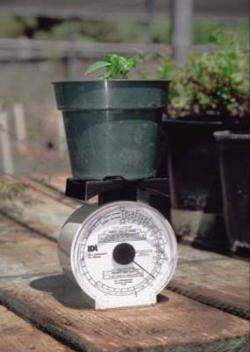
Crop water use
Plant water use in container nurseries can be measured directly by weighing plant containers (fig. 1). The weight change in grams over a 24-hour period, with no intervening irrigation, represents the milliliters of water lost from the container during that time (1 milliliter of water weighs 1 gram). As with the other methods described here, it is important to select representative plants when measuring water use. Large plants tend to use more water than small ones, and those on the borders of fields, benches, or nursery blocks tend to use more than those in the interior. Since accurate scales can be purchased for less than $100, this method provides a fast, accurate, inexpensive way to monitor plant water use.
Estimates of evapotranspiration for field-grown plants can be made using evaporation pans, automated weather stations (fig. 2), or atmometers, all of which can provide estimates of the amount of water loss in a given surface area. Evapotranspiration values are expressed in units of inches per day or centimeters per day. Evaporation pans measure water evaporated from a standard sized pan of water and then a correction
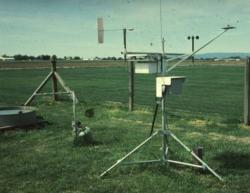
Direct measurement of soil moisture in the plant root zone can be made using moisture-sensing instruments such as tensiometers (fig. 3), resistance blocks, capacitance probes and time domain reflectance sensors. Capacitance probes and time domain reflectance sensors measure actual soil water content; tensiometers and resistance blocks measure soil suction, which indicates the relative ease with which plants can remove soil moisture. These instruments can be used to measure moisture in field soils or in container media, but resistance blocks do not perform well in coarse-textured media. The sensors should be placed in the root zone of plants selected to represent all of those in the irrigated area. Factors to consider when selecting representative plants include plant size and location. These moisture sensing instruments can be connected to computers or data loggers so that data can be collected continuously and irrigation valves can be set to operate based on the measured soil moisture values.
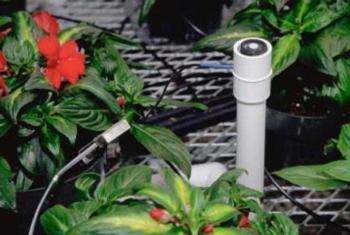
Fig. 3. A tensiometer probe for measuring moisture in media is connected by wire (lower left) to a computerized environmental monitoring and control system. The white tube contains a light sensor also used to help estimate irrigation need. Photo: J. K. Clark.
Improving Irrigation Efficiency
Many irrigation management practices can be implemented in greenhouses and nurseries to increase irrigation efficiency. The following is a list of some of these practices. Most of these suggested practices can be done in concert, and it may well be that some of the suggestions are not appropriate for some operations.
• Irrigation System Improvements. Many steps can be taken to improve the performance of the sprinkler and/or drip systems used for irrigation. An irrigation audit, in which the irrigation systems are evaluated for irrigation uniformity (fig. 4) and other irrigation performance measures, is an excellent first step in improving irrigation system performance. Regular maintenance of the irrigation system is critical. This includes detecting and repairing leaks (fig. 5), flushing to unclog lines, replacing worn nozzles (avoiding unintentional mixing of different-size sprinkler nozzles and drip emitters) and checking to ensure that appropriate pressure throughout the system is maintained (fig. 6).
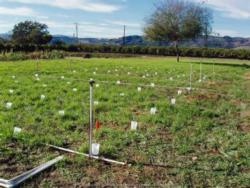
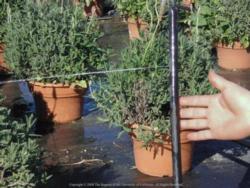
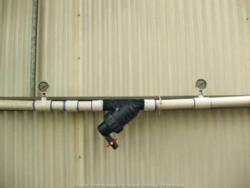
• Pulse Irrigations. Applying water in short, “pulsed” irrigation durations can significantly reduce runoff and improve irrigation efficiency. Pots hold only a certain volume of water, and any irrigation in excess of that amount simply runs through or off the pots. Multiple pulsed irrigations during the day can prevent runoff while satisfying plant needs.
• Irrigation Zones. Establishing zones in which irrigation is constant and can be controlled improves irrigation water management. It allows a nursery manager to operate only those zones needing irrigation for only the time needed.
• Group Plants with Similar Water Needs. Placing plants with similar irrigation needs together in an irrigation zone allows efficient irrigation water management. This prevents a situation in which the plants with the greatest water needs dictate the watering schedule, which can cause other plants to be overwatered.
• Avoid Irrigating Where No Plants Are Present. Avoiding applying water where there are no plants seems like common sense, but it can be difficult to accomplish. It is made easier when numerous irrigation zones, each of which can be controlled separately, provide increased irrigation control. As plants are sold, group remaining plants that have similar needs together and shut off irrigation in unused areas (fig. 7). When using overhead sprinkler systems on container plants, space plants as close as possible while still maintaining adequate light to minimize the empty area where water does not land in a pot. Adjustable sprinkler heads that irrigate only part of a circle should be used on the edges of irrigated areas to prevent water from landing on bare areas adjacent to plants during irrigation (fig. 8).
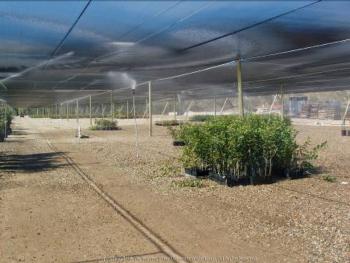
Fig. 7. In this photo, the overhead irrigation system is watering large areas with no plants. It is important to shut off irrigation in unused areas after plants are harvested for sale. Photo: D. Zurawski and J.P. Newman.
• Automation. Irrigation automation can improve water management, but it should be used in conjunction with good human management. In automated irrigation, a controller operates solenoid-equipped valves at specified times and durations. While the controller may be scheduled to turn the irrigation system on and off, it takes human management to determine whether there is too much runoff or too few or no plants in an irrigation zone being irrigated. Automation is a tool to help the operator improve water management, not a substitute for human judgment..
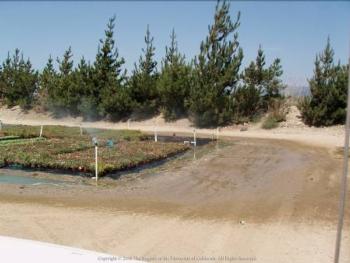
Fig. 8. Spray patterns of overhead irrigation systems should not create overspray in walkways and edges, as shown here. Photo: D. Zurawski and J. P. Newman.
Larry Schwankl is UC Cooperative Extension Irrigation Specialist, Kearney Agricultural Research and Extension Center; Richard Evans is UC Cooperative Extension Environmental Horticulturalist, Department of Plant Sciences, UC Davis; and Ben Faber is UC Cooperative Extension Farm Advisor in Ventura and Santa Barbara Counties.












